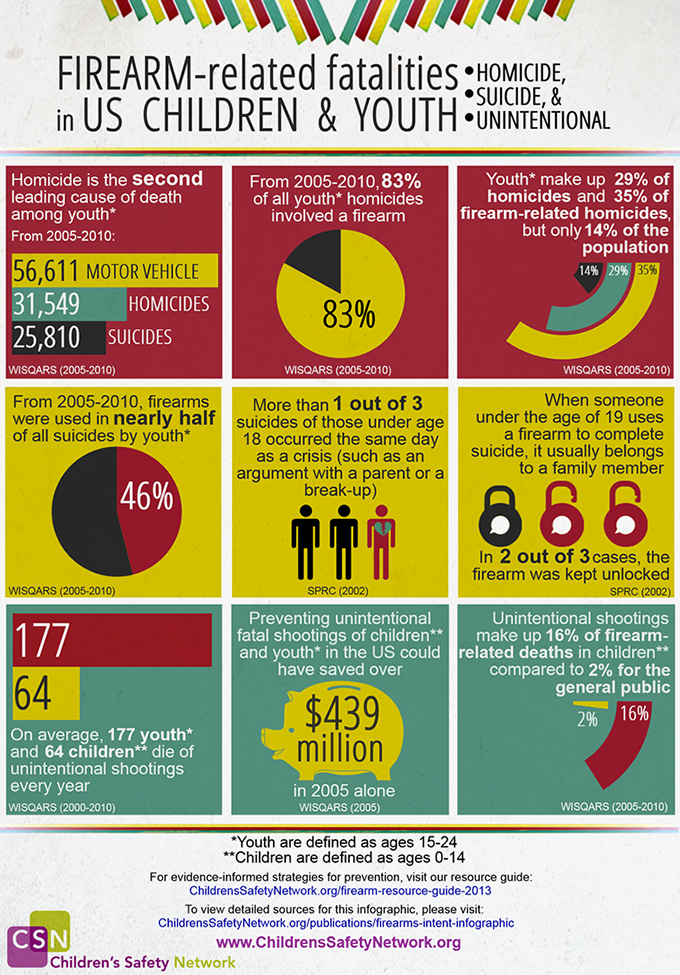
This infographic covers three types of firearm-related injuries and how they affect children and youth: homicide, suicide, and unintentional. This is the first in a three-part series of infographics about firearms.
The other infographics in the series are available here:
- The Magnitude of Firearm-Related Fatalities in Children and Youth
- Child Access to Firearms in the US
FIREARM-RELATED FATALITIES IN US CHILDREN & YOUTH: HOMICIDE, SUICIDE, AND UNINTENTIONAL
Homicide is the second leading cause of death among youth*
From 2005-2010:
- Motor vehicle: 56,611
- Homicide: 31,549
- Suicide: 25,810 (WISQARS, 2010)
From 2005-2010, 83% of all youth* homicides involved a firearm (WISQARS, 2010)
Youth* make up 29% of all homicides and 35% of all firearm-related homicides, but only 14% of the population (WISQARS, 2010)
Firearms are used in nearly half (46%) of all suicides by youth* (WISQARS, 2010)
More than 1 in 3 suicides of those under age 18 occurred the same day as a crisis (such as an argument with a parent or a break-up) (Suicide Prevention Resource Center & Harvard Injury Control Research Center, 2002)
When someone under the age of 19 uses a firearm to complete suicide, it usually belongs to a family member. In 2 out of 3 of these cases, the firearm was kept unlocked (Suicide Prevention Resource Center & Harvard Injury Control Research Center, 2002)
On average, 177 youth* and 64 children** die of unintentional shootings every year (WISQARS, 2000-2010)
Preventing unintentional fatal shootings of children and youth in the US could have saved over $439 million in 2005 alone (WISQARS, 2005)
Unintentional shootings make up 16% of firearm-related deaths in children** compared to 2% for the general public (WISQARS, 2010)
*Youth are defined as ages 15-24
**Children are defined as ages 0-14
For evidence-informed strategies for prevention, visit our resource guide: http://ChildrensSafetyNetwork.org/firearm-resource-guide-2013
The other infographics in the series are available here:
- The Magnitude of Firearm-Related Fatalities in Children and Youth
- Child Access to Firearms in the US
Sources
Suicide Prevention Resource Center, & Harvard Injury Control Research Center. (2002). Linking Data to Save Lives. NVISS Fact Sheet. Retrieved April 16, 2013, from http://www.sprc.org/sites/sprc.org/files/library/YouthSuicideFactSheet.pdf
WISQARS. (2000-2010). Fatal Injury Data. WISQARS (p. Accessed October 31st, 2013 by R. Hunt). Atlanta, GA. Retrieved from http://webappa.cdc.gov/sasweb/ncipc/mortrate10_us.html
WISQARS. (2005). Cost of Injury Reports. WISQARS (p. Accessed October 3rd, 2013 by R. Hunt). Atlanta, GA.
WISQARS. (2005-2010). Fatal Injury Data. WISQARS (p. Accessed April 15th, 2013 by R. Hunt). Atlanta, GA. Retrieved from http://webappa.cdc.gov/sasweb/ncipc/mortrate10_us.html